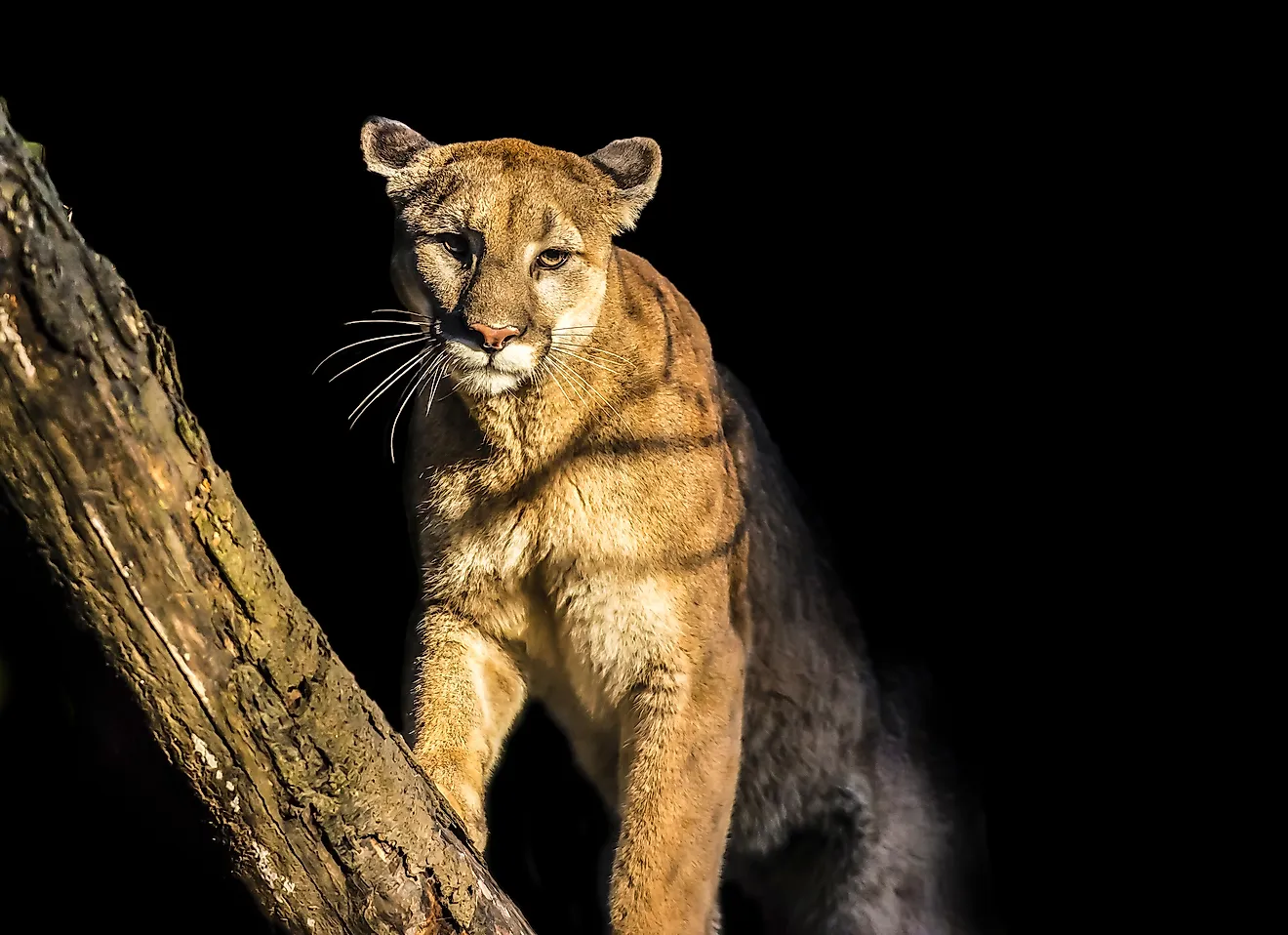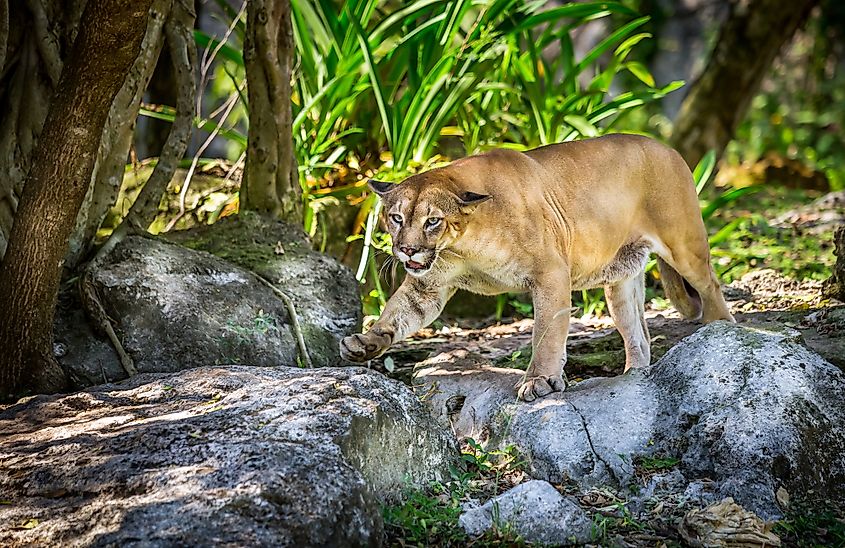
- Mountain lions are carnivorous mammals that go by many names. They are known as the puma, panther, catamount, panther, red deer, deer tiger, and yes, cougar.
- Due to the mountain lion’s adaptability, it is known to live in many habitats and ecosystems.
- Unlike other large felines, mountain lions don’t roar. Instead, they purr like small cats.
What is A Mountain Lion?
- Phylum: Chordata
- Class: Mammalia
- Order: Carnivora
- Family: Felidae
- Genus: Puma
- Species: concolor
- Binomial Name: Puma concolor (Linnaeus, 1771)
Mountain lions are carnivorous mammals that go by many names. They are known as the puma, panther, catamount, panther, deer tiger, and yes, cougar. They have more monikers than most other living animals. What they’re called depends mainly on their location. For instance, in southern California, they are mainly called mountain lions while in Florida most refer to them as panthers.
Where Do Mountain Lions Live?

Due to the mountain lion’s adaptability, they are known to live in many habitats and ecosystems. Apart from humans, they have the largest geographic range out of all native terrestrial mammals in the Western Hemisphere. They are found in 28 countries in the Americas, from southern Alaska to the southernmost tip of Chile in western South America.
Mountain lions can live in a wide variety of habitats like forests, prairies, deserts, and swamps. They thrive in mountainous terrain and steep, rocky canyons. They are also found are varying elevations ranging from sea level to around 3,000 m. Adult male’s have a home range of over 250 km2 while females occupy anywhere around 50 to 150 km2.
What Does A Mountain Lion Look Like?
What Is The Size Of Mountain Lions?
The mountain lion’s body from nose to tail tip is around 1.50 to 2.75 m long. Males are generally heavier than females at between 53 to 100 kg. Females can grow as heavy as 29 to 64 kg. The size of these animals vary widely depending on geographic location with the size increasing from near equatorial locations towards the poles.
Sounds Made By Mountain Lions
Unlike other large felines, mountain lions do not roar, instead, they purr like small cats. They make low-pitched growls, hiss, and purrs similar to those made by domestic felines. Females are known to make screams to attract males which is why they are also sometimes called “the mountain screamer.”
How Fast Can A Mountain Lion Run And How High Can It Jump?
Mountain lions, like cheetahs, have a flexible spine that lets them maneuver around obstacles or change the course of their run right away making them extremely fast runners and adept hunters. They are known to run as fast as 64 to 80 km per hour.
These mammals have extremely strong legs that help them jump long distances. Their muscular hind legs allow them to jump as high as 18 feet from the ground, although they are also known to jump up to 20 feet up or down mountains. They are known to leap from the ground to trees or jump from trees to pounce on prey on the ground.
What Do Mountain Lions Eat?
Mountain lions are carnivores, which means that they feed on other animals to survive. Its main prey is deer including the white-tailed deer, the elk, and even the largest ones, the moose. They are also known to hunt and eat other animals like goats and sheep or rodents like rabbits, capybaras, and porcupines. They are known to attack livestock and even animals twice their size like cattle and horses. They can even eat small animals like mice and birds.
When Are Mountain Lions Most Active?
Mountain lions are most active at night. They can be prowling during the day but they are most active at night most especially at dusk and dawn. During this time their primary prey, the deer, is also actively out roaming in the open.
Significance of Mountain Lions
Like every species on planet Earth, cougars also play an integral role in the ecosystems that they are part of. Being apex predators, their role in controlling the herbivore population is vital.
Mountain lions are also regarded as an umbrella species which means their conservation amounts to conserving all other species sharing their habitat. These predators occupy massive spaces – about 13 times the area occupied by black bears and 40 times that needed by a bobcat to thrive. Hence, preserving mountain lion habitats saves countless other species living there.
Do Mountain Lions Attack People?
Attacks on humans are extremely rare. They would rather flee than fight and they rarely try to confront humans. But since many developments have encroached on the animal’s habitats, encounters are becoming all too common. A cougar may attack if they feel cornered and usually bite the neck when attacking.
What is the Current Conservation Status of Mountain Lions?
The historic range of this species included nearly the entire Americas but now they are confined to only 28 countries. They were almost exterminated from eastern US due to extensive hunting throughout the 19th and 20th centuries as they were considered a risk to livestock. In the western US, mountain lion populations are currently stable but far lower than the historical figures. In 2011, a subspecies of the mountain lion, the eastern cougar was declared extinct by the U.S. Fish & Wildlife Service. Another mountain lion population, the Florida panther, is listed as critically endangered in the US endangered species list.
What Are The Threats To Mountain Lions?
Humans pose the biggest threat to these animals. Aside from encroaching on their habitat for urban development, humans also hunt these animals so much so that their populations are depleted in many parts of the Americas. Both legal and illegal hunting of mountain lions contributes to their decline. Many are hunted out of people’s fear of these animals, some are hunted because they are valued as trophies.
Mountain Lion Facts
| Feature | Fact |
|---|---|
| Scientific Name | Puma concolor |
| Classification | Mammal |
| Weight | 53 to 100 kg (males); 29 and 64 kg (females) |
| Body length (nose to tail tip) | 1.50 to 2.75 m |
| Speed | 64 to 80 kmph |
| Diet | Carnivores. Preys on deer, moose, smaller mammals, birds, reptiles, etc. |
| Lifespan | 8 to 13yrs |
| Gestation | Approx. 91 days |
| Litter size | 1 to 6 cubs, typically 2 |
| Nature | Mostly solitary |
| Conservation Status | Least Concern |



 Users Today : 21
Users Today : 21 Total views : 666890
Total views : 666890